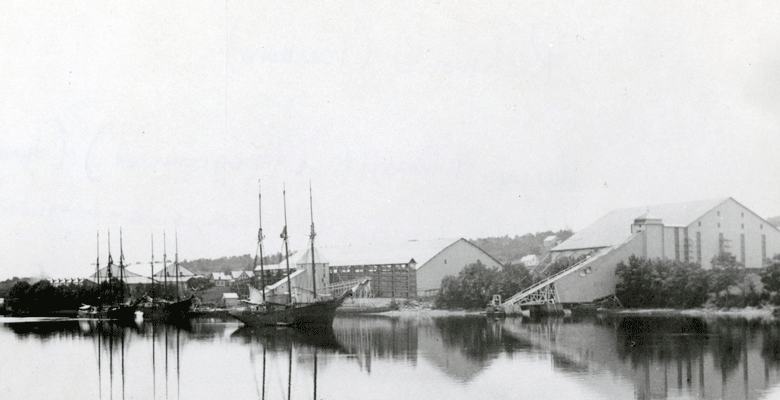This time of year, Mainers look forward to the thaw and the coming of warmer weather. It is a time to look ahead to the opportunities that a Maine summer provides, a time when waterfronts are buzzing with seasonal industries and activities in comparison to the stalling effects of a frigid winter.
For a period of Maine’s history, this was not so much the case. During the latter-half of the 19th century, Maine was the center of a major inland waterway industry, one that actually relied on wintry conditions, employed thousands of people, and the need for it was fueled by the return of summer weather.
That industry was ice.
The wintry harvest could yield over one million tons of ice from this segment of the Kennebec…
The center of this frozen water trade was a 20-mile stretch of the Kennebec River, from the top of Merrymeeting Bay to Augusta. When ice was at least 12-inches thick, ice harvesters measured and marked the frozen surfaces of bodies of water all over Maine to be sawed into blocks of ice. The ice was then stacked in huge warehouse structures using ramp and elevator systems to await the spring thaw for transport.
The wintry harvest could yield over one million tons of ice from this segment of the Kennebec, which was lauded for its quality clear ice. In today’s dollars this equates to a billion-dollar industry.
The season for shipping ice was late spring to the late fall. The cargo was insulated using hay or wood-waste products such as shavings, chips, or sawdust. Shockingly, the melt was minimal—even on voyages to tropical climates—rarely reaching a 30 percent loss. The ice remaining in the ice houses at the end of the shipping season also saw little loss and became part of next season’s cargoes.
The image included, circa 1890, depicts schooners lined up along Richmond riverbanks ready to fill their holds with ice. The concentration of ice houses on the riverbanks of Richmond led to this part of town being called Iceboro, a moniker that still shows up on maps today.
This view alone shows five of them. Iceboro even had its own post office in the 1870s and 1880s. There is no present-day evidence at this site of the significant industry that existed here.
While Maine ice made its way to southern ports and distant, tropical climates, there was also a major need in domestic urban areas.
“Big Ice” developed with smaller, local operations being bought out by those based in cities such as Baltimore, New York, and Philadelphia.
Most significantly, a monopoly over ice distribution in New York City resulted in price-fixing in the midst of summer heat waves. While the ice industry was ultimately killed by the development of refrigeration, the monopoly hastened the shift from natural ice—even amid skepticism of “artificial” ice. As a result, Maine’s frozen-water commerce ultimately expired in the early 1900s and what remained was largely for local consumption.
Kelly Page is collections and library services manager for Maine Maritime Museum in Bath. Among the exhibits the museum is now featuring are “Cotton Town: Maine’s Economic Connections to Slavery” and “Arthur Beaumont: Art of the Sea.” Explore resources and plan your visit at www.MaineMaritimeMuseum.org.





